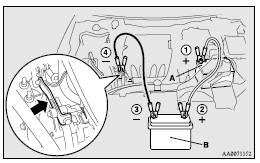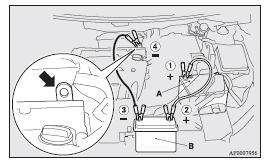
Mitsubishi Lancer Owners Manual
Emergency startingFor emergencies / Emergency starting
If the engine cannot be started because the battery is weak or dead, the battery from another vehicle can be used with jumper cables to start the engine.
![]()
► To start the engine using jumper cables connected to another vehicle, perform the correct procedures according to the instruction below. Incorrect procedures could result in a fire or explosion or damage to the vehicles.
![]()
► Do not attempt to start the engine by pulling or pushing the vehicle.
It could damage your vehicle.
► Always wear protective eye goggles when working near the battery.
► Keep the battery out of the reach of children.
1. Get the vehicles close enough so the jumper cables can reach, but be sure the vehicles aren’t touching each other.
![]()
► Check the other vehicle. It must have a 12-volt battery.
If the other system isn’t 12-volt, shorting can damage both vehicles.
2. Set the parking brake firmly on each vehicle.
Put an A/T, CVT or Twin Clutch SST in “P” (PARK) or a M/T in “N” (Neutral). Turn off the ignition switch.
![]()
► Turn off the ignition on both vehicles beforehand.
Make sure that the cables or your clothes cannot be caught by the fan or drive belt. Personal injury could result.
3. Turn off all lamps, heater and other electrical loads.
4. Make sure battery electrolyte is at the proper level. Refer to “Battery”.
![]()
► If electrolyte fluid is not visible, or appears to be frozen, Do Not Attempt
Jump Starting!
A battery might rupture or explode if the temperature is below the freezing point
or if it is not filled to the proper level.
5. For petrol-powered vehicles equipped with turbocharger, remove the air duct
and then the battery upper cover. (Refer to “Removing and installing the battery
upper cover”.)
6. Connect one end of one jumper cable to the positive (+) terminal of the discharged
battery (A), and the other end to the positive (+) terminal of the booster battery
(B).
1600 models

1800 models (petrol-powered vehicles), 2000 models

1800 models (diesel-powered vehicles)

7. Connect one end of the other jumper cable to the negative (-) terminal of the booster battery, and the other end to the engine block of the vehicle with the discharged battery at the point farthest from the battery.
![]()
► Be sure to observe the connecting sequence of
 .
.
► Make sure that the connection
 is made to the appointed position
is made to the appointed position
If the connection is made directly to the negative side of the battery, the inflammable gasses generated from the battery might catch fire and explode.
► When connecting the jumper cable, do not connect the positive (+) cable to the negative (-) terminal. Otherwise sparks might cause explosion of the battery.
![]()
► Take care not to get the jumper cable caught in the cooling fan or other
rotating part in the engine compartment.
► Use the proper cables suitable for the battery size to prevent overheating of
the cables.
► Check the jumper cables for damage and corrosion before use.
8. Start the engine in the vehicle which has the booster battery, let the engine idle a few minutes, then start the engine in the vehicle with the discharged battery.
![]()
► Keep the engine of the vehicle giving assistance running.
![]() Note
Note
► For vehicles equipped with the Auto Stop & Go (AS&G) system, press the “Auto
Stop & Go (AS&G) OFF” switch to deactivate the Auto Stop & Go (AS&G) system and
prevent the engine from automatically stopping before the battery is sufficiently
charged. Refer to “To deactivate”.
► If the engine is started with the air duct removed, the noise produced as air
is drawn into the engine will be greater than when the duct is installed.
9. After the engine is started, disconnect the cables in the reverse order and keep the engine running for several minutes.
10. For petrol-powered vehicles equipped with turbocharger, install the battery upper cover and then the air duct. (Refer to “Removing and installing the battery upper cover”.)
![]()
► If the battery has to be charged while fitted in the vehicle, disconnect
the vehicle side negative (-) terminal connected to the battery.
► Keep sparks, cigarettes and flames away from the battery because the battery may
produce an explosion.
► Use adequate ventilation when charging or using the battery in an enclosed space.
► Remove all the caps before charging the battery.
► Electrolyte is corrosive diluted sulphuric acid.
If electrolyte (battery acid) comes into contact with your hands, eyes, clothes
and the painted surface of your vehicle, it should be thoroughly flushed with water.
If electrolyte gets in your eyes, flush them with water immediately and thoroughly,
and get prompt medical attention.
![]() Note
Note
► If the vehicle is put in motion without fully charging the battery, it might cause the loss of smooth engine operation and the anti-lock brake warning lamp to illuminate. Refer to “Anti-lock brake system (ABS)”.






